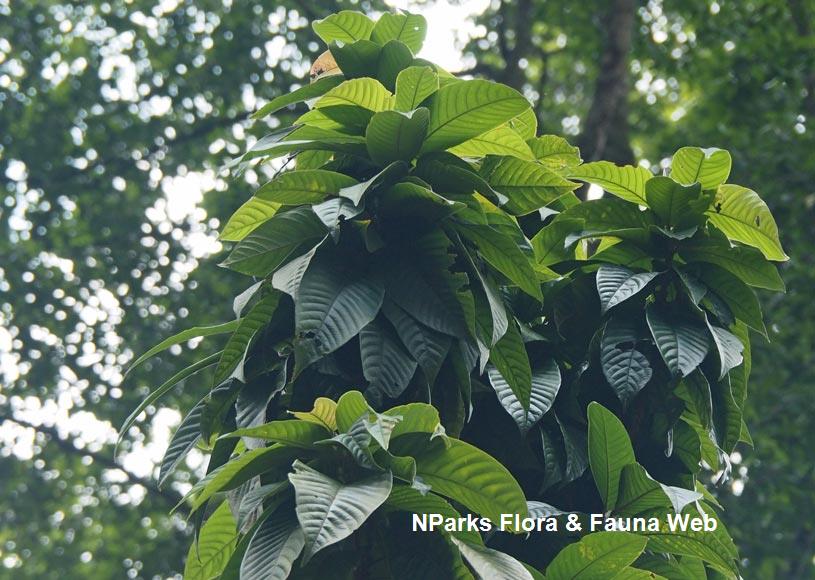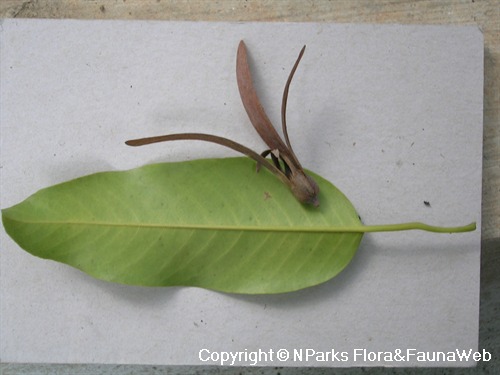
Back
Anthoshorea bentongensis (Foxw.) P.S.Ashton & J.Heck.
| Family Name: | Dipterocarpaceae |
| Synonyms: | Shorea bentongensis Foxw., Shorea pahangensis Foxw. |
| Common Name: | Meranti Mengkai, Meranti Sega, Bok |
Anthoshorea bentongensis, also known as Meranti Mengkai, is a tree endemic to Peninsular Malaysia. Growing up to 50 m tall, it has winged fruit that are dispersed by wind. It produces white meranti timber that is prized regionally for construction and plywood.
Name
Classifications and Characteristics
| Plant Division | Angiosperms (Flowering Seed Plants) |
|---|---|
| Plant Growth Form | Tree |
| Lifespan (in Singapore) | Perennial |
| Mode of Nutrition | Autotrophic |
| Plant Shape | Broad / Mushroom / Hemispherical |
| Maximum Height | 50 m |
| Tree or Palm – Trunk Diameter | 2.5 m |
Biogeography
| Native Distribution | Endemic to Peninsular Malaysia (Selangor, Pahang, Johor). |
|---|---|
| Native Habitat | Terrestrial |
| Preferred Climate Zone | Tropical |
| Local Conservation Status | Non-native |
Description and Ethnobotany
| Growth Form | It is a tree, up to 50 m tall and 2.5 m girth, with buttresses. |
|---|---|
| Foliage | Leaves are leathery, broadly egg-shaped (7 – 15 cm long and 4 – 8 cm wide) with the leaf margin slightly curled downwards (subrevolute). Each leaf has 13 – 16 pairs of lateral veins. The midrib is depressed on the upper surface and the lateral veins are prominent on the underside. Leaf tip is prominent and slender (1.5 cm long) while the leaf base is slightly heart shaped to broadly wedged shaped. Stipule is broadly elliptic (12 mm long and 7 mm wide), falls off early and leaving behind a stipular scar. The petiole is short and stout (8 – 13 mm long). Both the stipules and petiole, along with the young twigs and leaf buds, are covered with short beige to brown hairs. |
| Flowers | Flowers occur in a cluster as a panicle inflorescence at the terminal or axillary position. Inflorescence is single-branched, reaching up to 6 cm long. Flower is pale yellow, with 15 stamens with oblong to strap-shaped anthers. The appendages are very slender and about thrice the length of the anthers. The ovary is oval shaped with a long tapering style. |
| Fruit | The fruit is winged and dry. They are borne on stalks which are 3 mm long. Each fruit comprises of three longer calyx lobes (7.5 cm long and 0.8 cm wide), two shorter lobes (1.2 cm long and 0.2 mm wide) and one oval-shaped nut (2 cm long and 2.5 cm wide) with a long linear style remnant at the tip (0.4cm long). |
| Habitat | It is found in evergreen to semi-evergreen lowland forests. |
| Similar | It closely resembles Shorea hypochra and Shorea roxburghii. S. bentongensis is an evergreen tree with 13 – 16 pairs of lateral veins, midrib that is depressed on the upper surface, short petiole (0.8 – 1.3 cm long) and fruit calyx lobes about twice the length of the nut. On the other hand, S. hypochra has at least 15 pairs of lateral veins, longer petiole (at least 2 cm long) and fruit calyx lobes at least thrice as long as the nut. While S. roxburghii is deciduous or semi-deciduous and has a flattened midrib. |
| Associated Fauna | Flowers are pollinated by insects. |
| Taxonomy | It is first collected in Bentong district of Pahang in 1919 and described by Foxworthy in 1932. |
| Cultivation | It can be propagated by seed. Seeds rapidly loses their viability and freshly collected seeds are best sown quickly for high germination rate. Seedlings require shaded condition until they reach a height of about 1.5 m. The young trees show a tendency to form multiple leader when exposed to full sun. Beetles of the family Scolytidae can cause damage to fruits. |
| Etymology | Latin Shorea, commemorating Sir John Shore (1793-1798), the Governor-General for the British East India Company; Latin bentongensis, refers to Bentong district in Pahang, Malaysia, one of the places where it occurs naturally. |
| Ethnobotanical Uses | Timber & Products: It produces white meranti timber, a lightweight hardwood. The logs float and are often transported by river. The wood is treated and used for a wide variety of purposes such as furniture making, door and window frames, rafters and joists. It is also prized as a plywood and veneer timber. The wood pulp can also be used to make paper. The high silica content present in the timber makes it difficult to saw and blunts the cutting tools easily. |
Landscaping Features
| Landscape Uses | Parks & Gardens |
|---|
Fauna, Pollination and Dispersal
| Pollination Method(s) | Biotic (Fauna) |
|---|---|
| Seed or Spore Dispersal | Abiotic |
Plant Care and Propagation
| Light Preference | Full Sun, Semi-Shade |
|---|---|
| Water Preference | Moderate Water |
| Plant Growth Rate | Slow |
| Rootzone Tolerance | Well-Drained Soils |
| Propagation Method | Seed |
| Propagule Establishment Remarks | Seedlings require shaded condition until they reach a height of about 1.5 m. The young trees show a tendency to form multiple leader when exposed to full sun. |
| Propagation Method Remarks | It can be propagated by seed. Seeds rapidly loses their viability and freshly collected seeds are best sown quickly for high germination rate. |
Foliar
| Foliage Retention | Evergreen |
|---|---|
| Mature Foliage Colour(s) | Green |
| Mature Foliage Texture(s) | Leathery |
| Foliar Type | Simple / Unifoliate |
| Foliar Arrangement Along Stem | Alternate |
| Foliar Attachment to Stem | Petiolate |
| Foliar Shape(s) | Non-Palm Foliage (Obovate) |
| Foliar Venation | Pinnate / Net |
| Foliar Margin | Entire |
| Foliar Apex - Tip | Acuminate |
| Foliar Base | Cordate, Cuneate |
Non - Foliar and Storage
| Trunk Type (Non Palm) | Woody |
|---|---|
| Mature Bark Texture | Fissured |
| Stem Type & Modification | Woody |
| Root Type | Underground |
Floral (Angiosperm)
| Flower & Plant Sexuality | Bisexual Flowers , Bisexual Flowers |
| Flower Colour(s) | Cream / Off-White |
|---|
| Flower Grouping | Cluster / Inflorescence |
| Flower Location | Axillary, Terminal |
| Flower Symmetry | Radial |
| Individual Flower Shape | Saucer-shaped |
| Inflorescence Type | Panicle |
| Flowering Period | Every Few Years |
| Flowering Habit | Polycarpic |
Fruit, Seed and Spore
| Mature Fruit Colour(s) | Brown |
|---|---|
| Mature Fruit Texture(s) | Leathery |
| Fruit Classification | Simple Fruit |
| Fruit Type | |
| Seed Quantity Per Fruit | Few (1-5) |
References
| References | Ashton, P.S. (1982). Dipterocarpaceae. In: van Steenis, C.G.G.J. (ed.) Flora Malesiana, ser.1, vol. 9, part 2, pp. 237–552, 575–600. The Hague/Boston/London: Martinus Nijhoff/Dr. W. Junk Publishers. Soerianegara, I., and Lemmens, R.H.M.J. (Editors). 1993. Plant Resources of South-East Asia Volume 5 (1). Timber Trees: Major Commercial Timbers. Netherlands: Pudoc Scientific Publishers. 610 pages. Symington, C.F. (1935). Notes on Malayan Dipterocarpaceae III. Gardens’ Bulletin Straits Settlements 8 (4), Pg 265-292. |
|---|
Image Repository
Others
| Master ID | 30397 |
|---|---|
| Species ID | 4706 |
| Flora Disclaimer | The information in this website has been compiled from reliable sources, such as reference works on medicinal plants. It is not a substitute for medical advice or treatment and NParks does not purport to provide any medical advice. Readers should always consult his/her physician before using or consuming a plant for medicinal purposes. |







